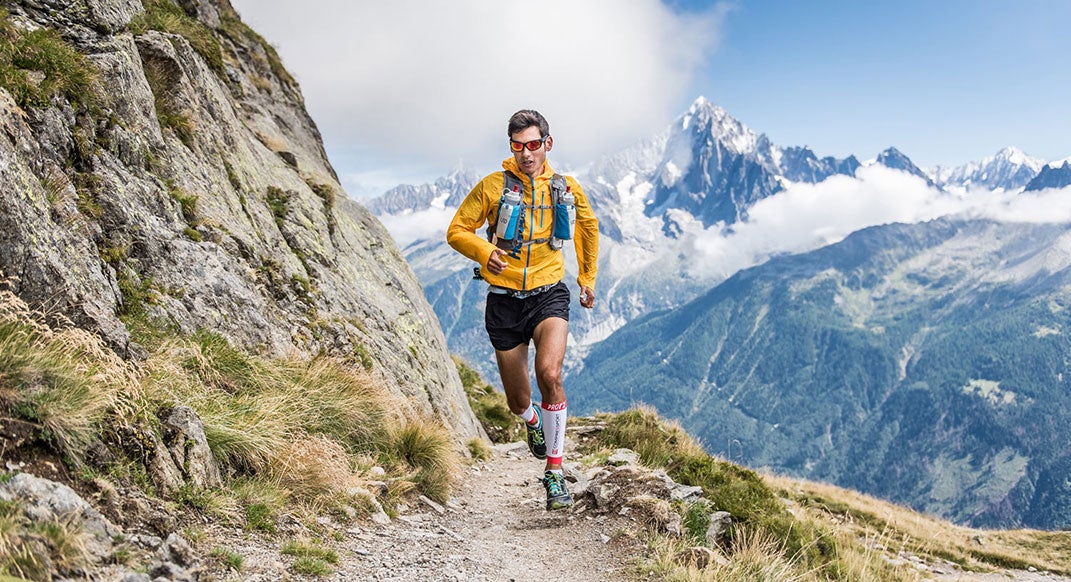Sage Canaday Takes on 100 Miles (Again)

For the last few years, Sage Canaday has torn up the trail-ultra circuit at distances up to 100K. He has racked up wins at competitive races like the Lake Sonoma 50 (2013), The North Face 50 Mile in San Francisco (2014) and the Speedgoat 50K (2013, 2014 and 2015).
But he has yet to really take on the marquee 100-mile distance. His one attempt thus far, at last August’s Ultra-Trail du Mont-Blanc (UTMB) in France, ended prematurely when he fell, gashing open his leg and requiring an airlift off the course.
But Canaday, 30, of Boulder, Colorado, will be giving it another try soon, and couldn’t have picked a bigger stage in U.S. ultrarunning: the Western States Endurance Run (WSER) 100-miler in June. Whereas UTMB features extensive technical mountain terrain, WSER is a faster, more run-heavy course with a net downhill.
We caught up with the star – more established these days than rising – to chat about his preparations and what he learned from his first 100-mile attempt, among other things.
First off, why Western States? It’s arguably the most competitive 100-miler in the U.S., so you’re certainly jumping in with both feet.
Well, I see it this way: Western States is to U.S. ultras what the Boston Marathon is to all U.S. marathons. The high level of competition, the history and the tradition is what attracts me to the race. For my first 100-mile race I’d like it to be on a big stage, and Western fits that bill.
You DNFed at UTMB, but it was due to a freak accident. Were you able to assess whether your training had gone well from those early miles, or how the rest of the race might have gone?
The lead pack at UTMB took it out hard and I don’t think I would’ve been able to maintain the pace of the winner. It’s hard to say what would have happened to me after 100 kilometers if I hadn’t fallen and gotten stitches, but I would have bet that my second half would have been a positive split.
What have you done differently for WSER compared to UTMB, and what have you been doing the same?
For Western I’ve been doing more intensity. As part of my buildup, I just raced Transvulcania, which is a rather extreme Skyrunning race for me. [Author’s note: he placed third.] I treat that as an intense stimulus because I prepped with some shorter hill repeats and tempo-run efforts.
Now I’m shifting my training into more long runs on flatter surfaces and increasing my mileage again, with a focus on runnable miles and runs in the 30-plus-mile range, which I’ve rarely ever done. I’ll also wear extra clothes for “heat training.”
Finally, there will be a focus on working on my weakness of runnable downhills. My climbing legs have been there since Transvulcania, and with the net downhill at Western States I think that is important. I also want to train on the course ahead of the race, like with any key race.
Right now, at peak mileage, what is a typical training week for you?
Generally, I’ll get in 100 to 120 miles a week and around 10,000 to 18,000 feet of climbing. Probably three to four times a week I’m running at an easy pace, and I’m running twice a day. Once a week, on average, I’ll do a 20-mile-plus long run in three to four hours, depending on the trail. Another time during the week I may do a 30- to 40-minute tempo run or something like 6 x 5 minutes hard.
It seems like you’re racing quite a bit in the buildup. Since 100 miles is an unprecedented race distance for you, are you concerned at all about overtraining or injury?
I’m actually racing a lot less than I have in the past. Usually Transvulcania is my fourth ultra of the year; this year it’s only my second ultra, after the Black Canyon 100K.
Overtraining and over-racing is always a health concern, though, so usually my training is more conservative than my race schedule. I’d say Transvulcania isn’t that specific to Western, but knowing that downhill was my weakness at Transvulcania, it gives me feedback on what I really have to work on.
WSER is stacked, and often goes out fast. Do you have much of a race strategy at this point? Have you thought about when you’ll make your move, depending on how things shake out in front of you?
Well, a lot will depend on how hot the weather actually is and what the top runners do, but I’d like to monitor course-record splits for a general reference.
Other than that, I’m going to have to rely on going by feel and observing how a certain pace might be affecting other competitors. I think the course record has the potential to go down, even on a semi-hot year.
Then again, just getting to the finish line is always the first goal!
You’re very open about your training, not only displaying every run on Strava, but also frequently discussing your strategies on YouTube. Are you ever concerned that you are giving away your secrets?
I have nothing to hide! The “secret” is a lot of hard work, a healthy diet and being willing to punish yourself in races and hard workouts. That and periodized training.
At a certain point, training is individualized. If one of my competitors follows my schedule, it doesn’t mean it’s going to be the best for them at all. There are general tips and training practices that work well for all distance runners, but for my competition I know most of them have their own coaches, their own philosophies and their own opinions on their ideal training schedule. One can’t just scale back what I do on Strava and have it work super well.